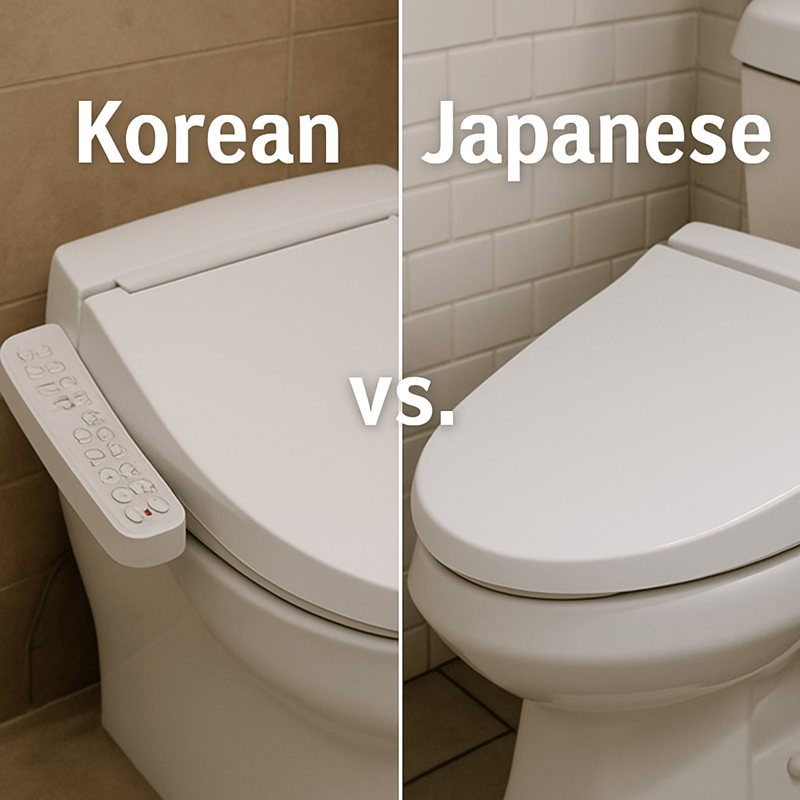
Bidets are now a common sight in both Korean and Japanese bathrooms—but did you know they’re actually quite different? While both countries lead the world in high-tech hygiene, their bidets evolved with very different goals, designs, and cultural values in mind.
In this post, we’ll explore the key differences between Korean and Japanese bidets, from how they’re installed to how people use them—and why your choice might say more about your lifestyle than your toilet.
Bidet Structure
In Japan, bidets are typically built into the toilet from the beginning. These are called integrated bidet toilets, and they’re designed as a single, seamless unit. Brands like TOTO, INAX, and Panasonic focus on full-system bathroom solutions where the toilet and bidet are one piece.
In contrast, Korean bidets are usually seat attachments—designed to be installed on top of a regular toilet. This modular design makes them perfect for apartments and small-space bathrooms, which are common in Korea.
✅ Japan: Built-in, all-in-one systems
✅ Korea: Flexible, easy-to-install bidet seats
Korea’s Bidet Boom: How a Luxury Gadget Became a Bathroom Essential 👆
Service Model
This is where things get really interesting.
In Japan, bidets are usually purchased outright and maintained by the user. You buy the product, install it, and take care of it yourself. It’s a classic one-time purchase model.
But in Korea, the market is built around rental services. Companies like Coway, ChungHo, and LG offer monthly rental plans that include installation, regular maintenance, nozzle sterilization, and repairs. This makes bidets more accessible and hassle-free.
✅ Japan: One-time purchase, user-maintained
✅ Korea: Subscription-style rentals with full service included
The One Big Difference Between a Bidet and a Washlet 👆
Feature Differences
Both countries offer the basics: warm water, heated seats, air dryers, and self-cleaning nozzles. But the way features are prioritized is different.
Korean bidets often emphasize:
-
Direct water supply (no tank) for hygiene
-
Big, easy-to-read buttons in Korean
-
Specialized modes for women, children, and elderly users
Japanese bidets, meanwhile, focus on:
-
Highly precise water temperature and pressure control
-
Deodorizing systems and even water sound simulators for privacy
-
Smart features like automatic lid opening and flushing
✅ Korea: Hygiene-first, user-friendly, life-stage specific
✅ Japan: Silent, precise, and privacy-optimized
How the Electronic Bidet Evolved 👆
Cultural Perspective
These design choices reflect deeper cultural values.
In Japan, cleanliness is closely tied to privacy and quietness. Many people use bidets in public restrooms, so features like noise-canceling water sounds and odor control are extremely important.
In Korea, bidets are viewed as practical hygiene devices for the whole family. The emphasis is on functionality, ease of use, and customer service, with a strong focus on elderly care, postpartum hygiene, and family wellness.
The Origins of the Bidet: A Forgotten French Invention 👆
Brand Showdown
Top Japanese brands:
-
TOTO (Washlet)
-
INAX
-
Panasonic
Top Korean brands:
-
Coway
-
LG PuriCare
-
ChungHo Nais
-
Samsung (select models)
Each brand dominates its home market and is expanding rapidly into global markets.
Final Thoughts
Though they may look similar, Korean and Japanese bidets are built on totally different philosophies
| Feature | 🇯🇵 Japanese Bidets | 🇰🇷 Korean Bidets |
|---|---|---|
| Design | Built-in, integrated | Seat-style, modular |
| Ownership | One-time purchase | Rental with service |
| Focus | Privacy, precision | Hygiene, convenience |
| User culture | Quiet, self-managed use | Family-friendly, serviced |
| Top brand | TOTO | Coway |
So, which one is better?
That depends on what you value most—discreet, polished engineering or customized, hassle-free hygiene.
Next up, we’ll compare TOTO Washlet vs. Coway premium bidet models head-to-head. Want to know which brand fits your lifestyle best? Subscribe and don’t miss the breakdown.
Korea’s Bidet Boom: How a Luxury Gadget Became a Bathroom Essential
[…] Korean vs. Japanese Bidets […]